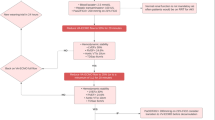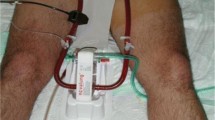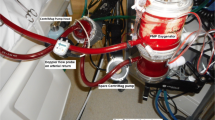Abstract
Conversion from peripheral extracorporeal life support (ECLS) to the central one can improve and stabilize hemodynamics in patients with refractory congestive heart failure-related multiorgan failure, whereas indication and selection of the type of the central ECLS have not been fully established. Institutional outcome of the conversion therapy was herein reviewed to verify indication and selection of three types of central ECLS. This study enrolled an institutional consecutive surgical series of 24 patients with refractory congestive heart failure under peripheral ECLS, related to fulminant myocarditis (n = 15), dilated cardiomyopathy (n = 5), or acute myocardial infarction (n = 4). They were converted to central Y-extracorporeal membrane oxygenation (ECMO, n = 6), extracorporeal ventricular assist device (EC-VAD, n = 12), or pump catheter (n = 6), dependent upon the degree of multiorgan failure. Despite the different degree of multiorgan failure prior to the conversion, improvement in end-organ perfusion and reduction in right atrial and pulmonary artery pressure were promptly achieved regardless of the type of the central ECLS. There were five in-hospital mortalities (21%) during the central ECLS, whereas mechanical support was weaned-off in 11 cases (46%) and durable LVAD was subsequently implanted for bridge to transplantation in eight cases (33%). Conversion from the peripheral ECLS to the central ones, such as central Y-ECMO, EC-VAD or pump catheter, promptly established a sufficient support with heart and lung unloading in patients with refractory congestive heart failure.




Similar content being viewed by others
References
Tariq S, Gass A. Use of extracorporeal membrane oxygenation in refractory cardiogenic shock. Cardiol Rev. 2016;24:26–9.
Shah M, Patnaik S, Patel B, Ram P, Garg L, Agarwal M, et al. Trends in mechanical circulatory support use and hospital mortality among patients with acute myocardial infarction and non-infarction related cardiogenic shock in the united states. Clin Res Cardiol. 2018;107:287–303.
Centofanti P, Attisani M, La Torre M, Ricci D, Boffini M, Baronetto A, et al. Left ventricular unloading during peripheral extracorporeal membrane oxygenator support: a bridge to life in profound cardiogenic shock. J Extra-corp Technol. 2017;49:201–5.
Seguchi O, Fujita T, Watanabe T, Kuroda K, Hisamatsu E, Nakajima S, et al. Temporary biventricular support with extracorporeal membrane oxygenation: a feasible therapeutic approach for cardiogenic shock with multiple organ failure. J Artif Organs. 2017;20:206–14.
Takeda K, Garan AR, Topkara VK, Kirtane AJ, Karmpaliotis D, Kurlansky P, et al. Novel minimally invasive surgical approach using an external ventricular assist device and extracorporeal membrane oxygenation in refractory cardiogenic shock. Eur J Cardiothorac Surg. 2017;51:591–6.
Schibilsky D, Lausberg H, Haller C, Lenglinger M, Woernle B, Haeberle H, et al. Impella 5.0 support in intermacs ii cardiogenic shock patients using right and left axillary artery access. Artif Organs. 2015;39:660–3.
Saito S, Toda K, Miyagawa S, Yoshikawa Y, Hata H, Yoshioka D, et al. Diagnosis, medical treatment, and stepwise mechanical circulatory support for fulminat myocarditis. J Artif Organs. 2018;21:172–9.
Matsumoto M, Asaumi Y, Nakamura Y, Nakatani T, Nagai T, Kanaya T, et al. Clinical determinants of successful weaning from extracorporeal membrane oxygenation in patients with fulminant myocarditis. ESC Heart Fail. 2018;5:675–84.
Cheng R, Tank R, Ramzy D, Azarbal B, Chung J, Esmailian F, et al. Clinical outcomes of impella microaxial devices used to salvage cardiogenic shock as a bridge-to-durable circulatory support or cardiac transplantation. ASAIO J. 2018;65:642–8.
Mourad M, Gaudard P, De La Arena P, Eliet J, Zeroual N, Rouviere P, et al. Circulatory support with extracorporeal membrane oxygenation and/or impella for cardiogenic shock during myocardial infarction. ASAIO J. 2018;64:708–14.
den Uil CA, Akin S, Jewbali LS, Dos Reis MD, Brugts JJ, Constantinescu AA, et al. Short-term mechanical circulatory support as a bridge-to-durable left ventricular assist device implantation in refractory cardiogenic shock: a systematic review and meta-analysis. Eur J Cardiothorac Surg. 2017;52:14–25.
Author information
Authors and Affiliations
Corresponding author
Ethics declarations
Conflict of interest
No conflict of interests related to this manuscript.
Additional information
Publisher's Note
Springer Nature remains neutral with regard to jurisdictional claims in published maps and institutional affiliations.
Rights and permissions
About this article
Cite this article
Fukushima, S., Tadokoro, N., Koga, A. et al. Central conversion from peripheral extracorporeal life support for patients with refractory congestive heart failure. J Artif Organs 23, 214–224 (2020). https://doi.org/10.1007/s10047-020-01157-0
Received:
Accepted:
Published:
Issue Date:
DOI: https://doi.org/10.1007/s10047-020-01157-0




